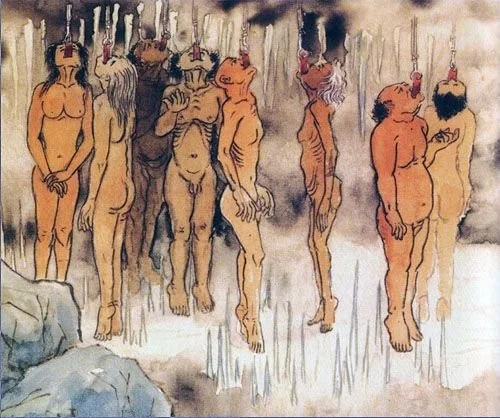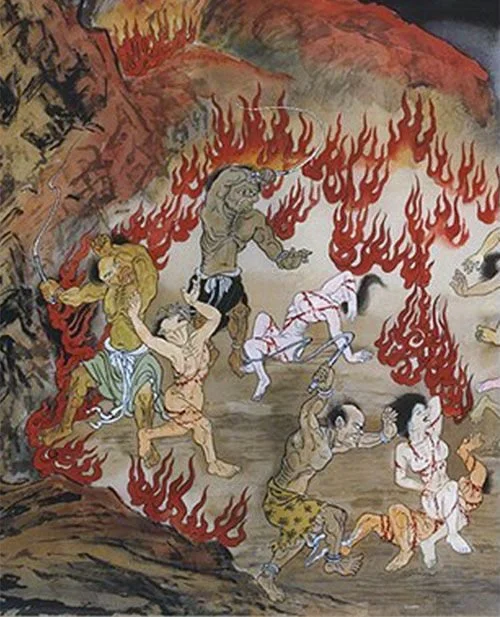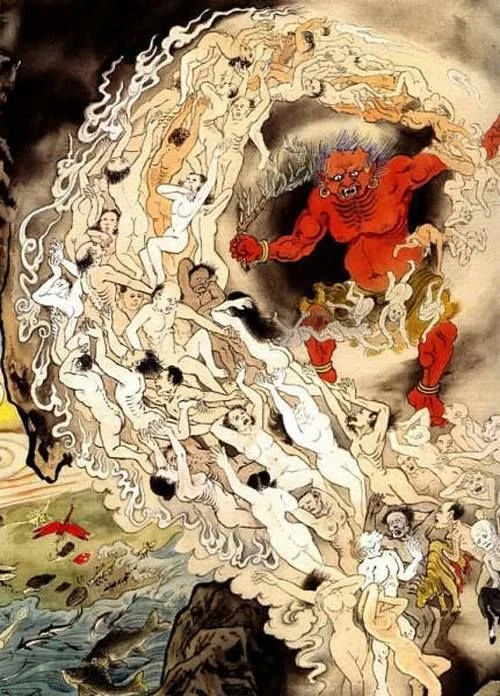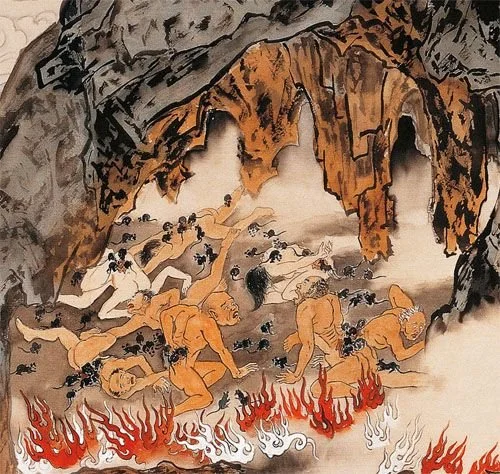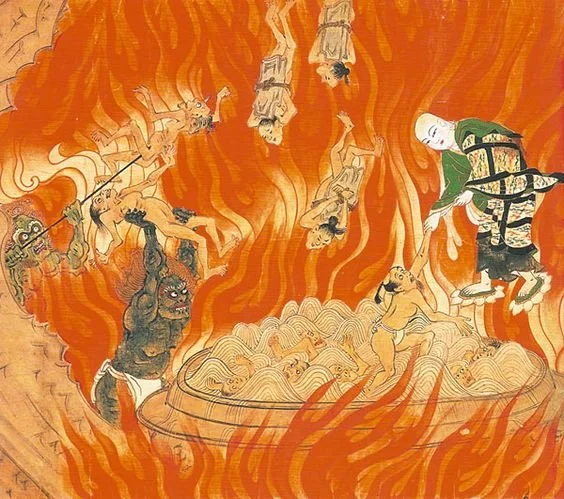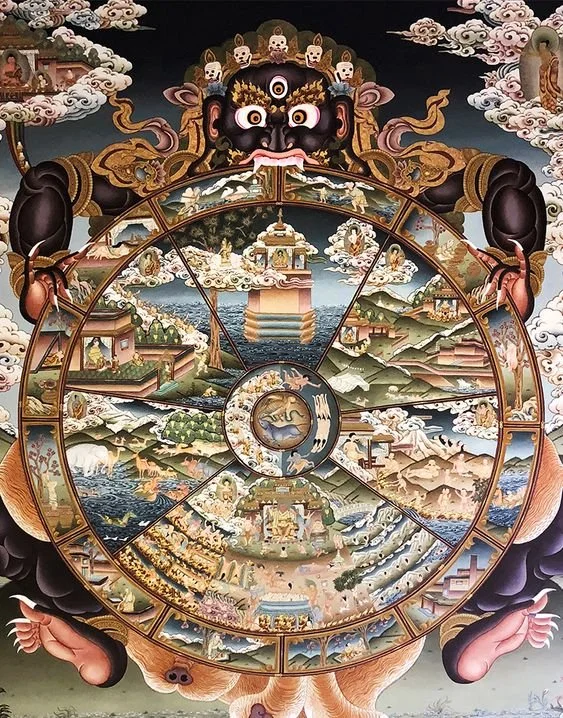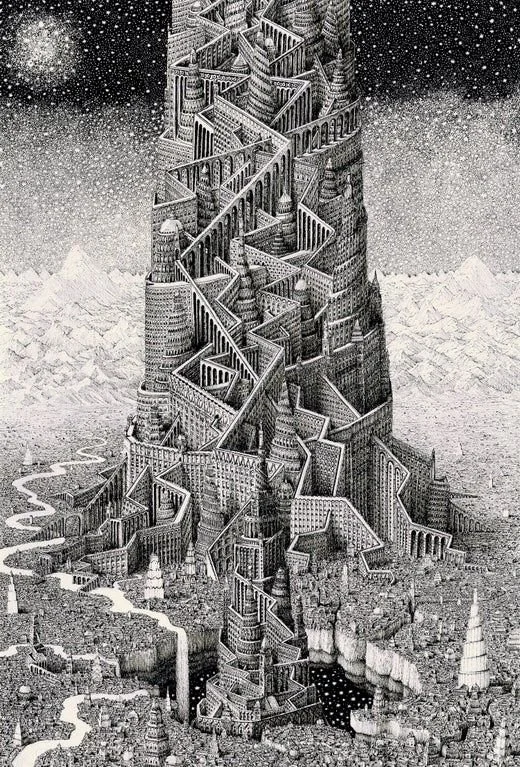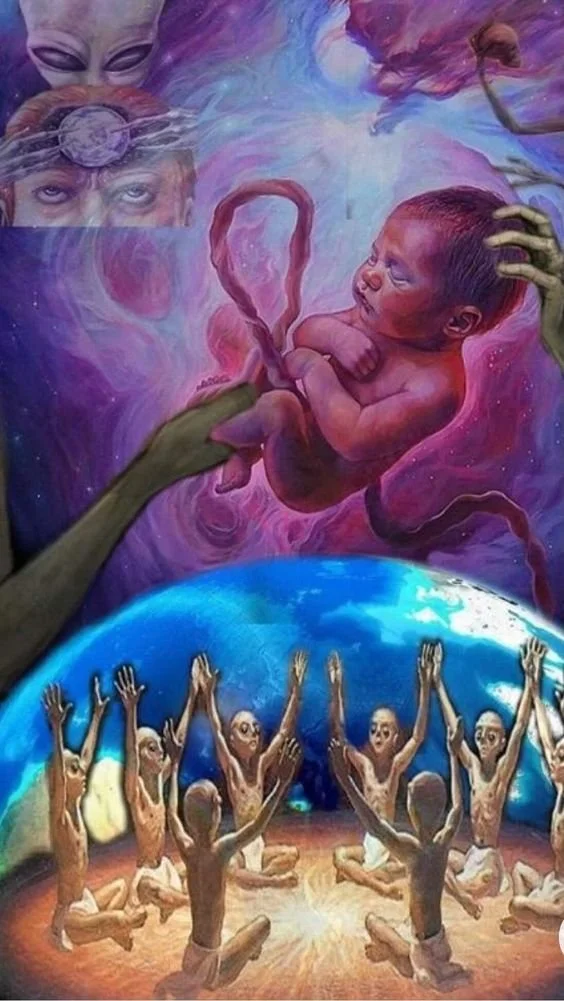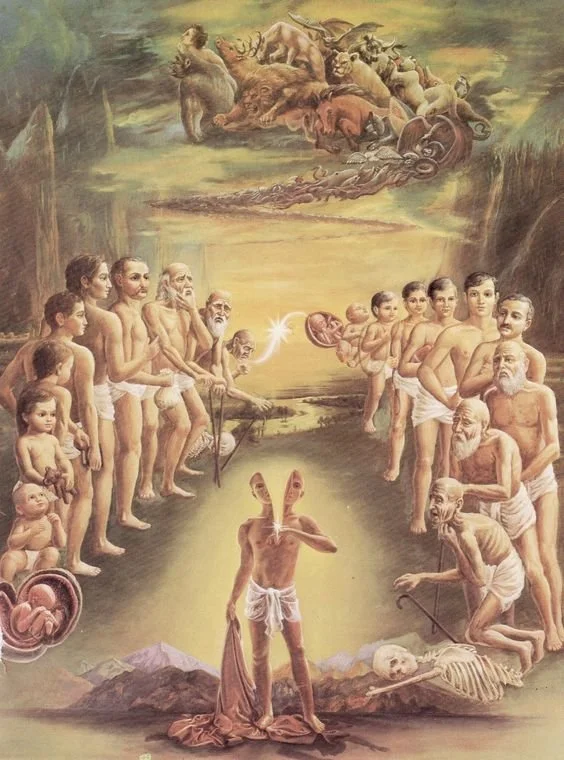Samsara
The Karmic Cycle
-
Saṃsāra
Source: https://en.wikipedia.org/wiki/Sa%E1%B9%83s%C4%81ra Saṃsāra (Devanagari: संसार) is a Pali/Sanskrit word that means "world", primarily used today to refer to the process of reincarnation: the "cyclicality of all life, matter, existence", a fundamental belief of most Indian religions. Popularly, it is the cycle of death and rebirth. Saṃsāra is sometimes referred to with terms or phrases such as transmigration/reincarnation, karmic cycle, or Punarjanman, and "cycle of aimless drifting, wandering or mundane existence".
-
The concept of saṃsāra has roots in the post-Vedic literature; the theory is not discussed in the Vedas themselves. It appears in developed form, but without mechanistic details, in the early Upanishads. The full exposition of the saṃsāra doctrine is found in Śramaṇic movements such as early Buddhism and Jainism, as well as various schools of Hindu philosophy after about the mid-1st millennium BCE.
-
The saṃsāra doctrine is tied to the karma theory of Hinduism, and the liberation from saṃsāra has been at the core of the spiritual quest of Indian traditions, as well as their internal disagreements. The liberation from saṃsāra is called Moksha, Nirvāṇa, Mukti, or Kaivalya.
-
According to Monier-Williams, saṃsāra is rooted in the term Saṃsṛ (संसृ), which means "to go round, revolve, pass through a succession of states, to go towards or obtain, moving in a circuit". A conceptual form from this root appears in ancient texts as saṃsaraṇa, which means "going around through a succession of states, birth, rebirth of living beings and the world", without obstruction.
-
The term shortens to saṃsāra, referring to the same concept, as a "passage through successive states of mundane existence", a transmigration, metempsychosis, a circuit of living where one repeats previous states, from one body to another, a worldly life of constant change, that is rebirth, growth, decay and redeath.
-
Punarmrityu: redeath
While saṃsāra is usually described as rebirth and reincarnation (Punarjanman) of living beings (Jiva), the chronological development of the idea over its history began with the questions on what is the true nature of human existence and whether people die only once. This led first to the concepts of Punarmṛtyu ("redeath") and Punaravṛtti ("return").
-
These early theories asserted that the nature of human existence involves two realities, one unchanging absolute Atman (Self) which is somehow connected to the ultimate unchanging immortal reality and bliss called Brahman, and that the rest is the always-changing subject (body) in a phenomenal world (Maya).
-
Redeath, in the Vedic theosophical speculations, reflected the end of "blissful years spent in svarga or heaven", and it was followed by rebirth back in the phenomenal world. Saṃsāra developed into a foundational theory of the nature of existence, shared by all Indian religions.
-
Evolution of ideas
Across different religions, different soteriology were emphasized as the saṃsāra theories evolved in respective Indian traditions. For example, in their saṃsāra theories, states Obeyesekere, the Hindu traditions accepted Ātman or Self exists and asserted it to be the unchanging essence of each living being, while Buddhist traditions denied such a soul exists and developed the concept of Anattā.
-
Salvation (moksha, mukti) in the Hindu traditions was described using the concepts of Ātman (self) and Brahman (universal reality), while in Buddhism it (nirvāṇa, nibbāna) was described through the concept of Anattā (no self) and Śūnyatā (emptiness).
-
Hinduism
In Hinduism, saṃsāra is a journey of the Ātman. The body dies, assert the Hindu traditions, but not the Ātman, which it assumes to be the eternal reality, indestructible, and bliss. Everything and all existence is connected, cyclical, and composed of two things: the Self, or Ātman, and the body, or matter. This eternal Self called Ātman never reincarnates, it does not change and cannot change in the Hindu belief.
-
In contrast, the body and personality, can change, constantly changes, is born and dies. Current karma impacts the future circumstances in this life, as well as the future forms and realms of lives. Good intent and actions lead to good future, bad intent and actions lead to bad future, in the Hindu view of life. The journey of samsara allows the atman the opportunity to perform positive or negative karmas throughout each birth and make spiritual efforts to attain moksha.
-
A virtuous life, actions consistent with dharma, are believed by Hindus to contribute to a better future, whether in this life or future lives. The aim of spiritual pursuits, whether it be through the path of bhakti (devotion), karma (work), jñāna (knowledge), or raja (meditation) is self-liberation (moksha) from saṃsāra.
-
Jainism
Saṃsāra in Jainism represents the worldly life characterized by continuous rebirths and suffering in various realms of existence. The conceptual framework of the saṃsāra doctrine differs between the Jainism traditions and other Indian religions. For instance, in Jaina traditions, soul (jiva) is accepted as a truth, as is assumed in the Hindu traditions, but not assumed in the Buddhist traditions. However, saṃsāra or the cycle of rebirths, has a definite beginning and end in Jainism.
Souls begin their journey in a primordial state, and exist in a state of consciousness continuum that is constantly evolving through saṃsāra. Some evolve to a higher state, while some regress, a movement that is driven by karma. Further, Jaina traditions believe that there exist Ābhāvya (incapable), or a class of souls that can never attain moksha (liberation).
-
The Ābhāvya state of soul is entered after an intentional and shockingly evil act. Jainism considers souls as pluralistic each in a karma-saṃsāra cycle, and does not subscribe to Advaita style nondualism of Hinduism, or Advaya style nondualism of Buddhism.
-
The Jaina theosophy, like ancient Ajivika, but unlike Hindu and Buddhist theosophies, asserts that each soul passes through 8,400,000 birth-situations, as they circle through saṃsāra. As the soul cycles, states Padmanabh Jaini, Jainism traditions believe that it goes through five types of bodies: earth bodies, water bodies, fire bodies, air bodies and vegetable lives.
-
With all human and non-human activities, such as rainfall, agriculture, eating and even breathing, minuscule living beings are taking birth or dying, their souls are believed to be constantly changing bodies. Perturbing, harming or killing any life form, including any human being, is considered a sin in Jainism, with negative karmic effects. A liberated soul in Jainism is one who has gone beyond saṃsāra, is at the apex, is omniscient, remains there eternally, and is known as a Siddha.
-
Buddhism
Saṃsāra in Buddhism, states Jeff Wilson, is the "suffering-laden cycle of life, death, and rebirth, without beginning or end". Also referred to as the wheel of existence (Bhavacakra), it is often mentioned in Buddhist texts with the term punarbhava (rebirth, re-becoming); the liberation from this cycle of existence, Nirvāṇa, is the foundation and the most important purpose of Buddhism.
-
Saṃsāra is considered permanent in Buddhism, just like other Indian religions. Karma drives this permanent saṃsāra in Buddhist thought, states Paul Williams, and "short of attaining enlightenment, in each rebirth one is born and dies, to be reborn elsewhere in accordance with the completely impersonal causal nature of one's own karma; This endless cycle of birth, rebirth, and redeath is saṃsāra". The Four Noble Truths, accepted by all Buddhist traditions, are aimed at ending this saṃsāra-related re-becoming (rebirth) and associated cycles of suffering.
-
Japanese Buddhist Statuary
Source: https://www.onmarkproductions.com/html/six-states.shtml-
CYCLE OF SUFFERING
CYCLE OF SAMSARA
Other Translations
Six States of Existence
Six Roads of Reincarnation
Six Paths of Transmigration
Six Realms of Samsara
Six Karmic Realms of Rebirth
Six Directions of Reincarnation
Six Destinies
Wheel of Life
Six Paths (Jp. = Rokudō 六道 or Rokudō-rinne 六道輪廻 or Mutsu no Sekai 六つの世界). Buddhist concept stemming from Hindu philosophies. Commonly translated in English as the “Six Realms of Karmic Rebirth.”
-
Long before Buddhism's introduction to India, Hindu (Brahman) beliefs and traditions held sway. One important concept was "transmigration," more commonly known in the West as "reincarnation." It holds that all living things die and are reborn again. Your rebirth into the next life will be based on your behavior in your past life.
-
This rebirth occurs again and again. When Buddhism emerged in India around 500 BC, it too stressed this Hindu belief in transmigration, one that still plays a major role in modern Buddhist philosophy. The modern Buddhist concept of Karma is also a byproduct of ancient Hindu beliefs in transmigration and reincarnation.
-
Among Buddhists, all living beings are born into one of the six states of existence (Samsara in Sanskrit, the cycle of life and death). All are trapped in this wheel of life, as the Tibetans call it. All beings within the six realms are doomed to death and rebirth in a recurring cycle over countless ages -- unless they can break free from desire and attain enlightenment.
-
Further, upon death, all beings are reborn into a lower or a higher realm depending on their actions while still alive. This involves the concept of Karma and Karmic Retribution. The lowest three states are called the three evil paths, or three bad states.
-
Beings in Hell. Naraka-gati in Sanskrit. Jigokudō 地獄道 in Japanese. The lowest and worst realm, wracked by torture and characterized by aggression.
Hungry Ghosts. Preta-gati in Sanskrit. Gakidō 餓鬼道 in Japanese. The realm of hungry spirits; characterized by great craving and eternal starvation; “Scroll of the Hungry Ghosts” (Gaki Zōshi 餓鬼草紙).
Animals. Tiryagyoni-gati in Sanskrit. Chikushōdō 畜生道 in Japanese. The realm of animals and livestock, characterized by stupidity and servitude.
Asura. Asura-gati in Sanskrit. Ashuradō 阿修羅道 in Japanese. The realm of anger, jealousy, and constant war; the Asura (Ashura) are demigods, semi-blessed beings; they are powerful, fierce and quarrelsome; like humans, they are partly good and partly evil.
Humans. Manusya-gati in Sanskrit. Nindō 人道 in Japanese. The human realm; beings who are both good and evil; enlightenment is within their grasp, yet most are blinded and consumed by their desires.
Deva. Deva-gati in Sanskrit. Tendō 天道 in Japanese. The realm of heavenly beings filled with pleasure; the deva hold godlike powers; some reign over celestial kingdoms; most live in delightful happiness and splendor; they live for countless ages, but even the Deva belong to the world of suffering (samsara) -- for their powers blind them to the world of suffering and fill them with pride -- and thus even the Deva grow old and die; some say that because their pleasure is greatest, so too is their misery. See also the Tenbu page and Hachi Bushu (8 Legions) page.
Read More Devas The Shiny Ones Guardian Angels Read More click
-
IMPORTANT NOTE: This topic is much more complicated than presented above. In Buddhism, there are actually 28 forms of existence in the Three Realms (Skt: Triloka). The three realms, starting from the lowest, are:
Realm of Desire (Skt: Kamaloka, Kamadhatu). Beings from the six classes described above live in this realm. Here sexual passion and other forms of desire predominate.
Realm of Desireless Form, Realm of Pure Form (Skt: Rupaloka, Rupadhatu). In this realm live 18 classes of gods. Here sexual desire and the desire for food fall away, but the capacity for enjoyment and pleasure continues.
Realm of Formlessness, the Bodiless Realm (Skt: Arupaloka, Arupadhatu). In this realm live four classes of Deva. This is a purely spiritual continuum consisting of four heavens wherein one may be reborn.
The Shambhala Dictionary of Buddhism and Zen has this to say about the various forms of existence:
“Between the various forms of existence there is no essential difference, only a karmic difference of degree. In none of them is life without limits. However, it is only as a human that one can attain enlightenment. For this reason Buddhism esteems the human mode of existence more highly than that of the gods and speaks in this context of the “precious human body.” Incarnation as a human being is regarded as a rare opportunity in the cycle of samsara to escape the cycle and it is a challenge and obligation of humans to perceive this opportunity and strive toward liberation (enlightenment)........Although the gods are allotted a very long, happy life as a reward for previous good deeds, it is precisely this happiness that constitutes the primary hindrance on their path to liberation, since because of it they cannot recognize the truth of suffering.”
Read More Zaqqum Tree of Hell click
Seraphim - Samsara
Lyrics
Turn into in great disorder, ascendancy reflect
Unreasonable wasteful without fear
Desire expends infinitely, no one can escape
All over bramble nearly abyss of Sheol
Turn over! The darkness give me new life
Tremble and conceit
Feel sorrow! night come with me to break out
just sink into the dead sea
Creature just like a wither tree, stupid and stubborn to posterity
Samsara circle around eternity, no eternal life
Criticize the evil sinner, despise the base soul
Hardships time is fleeting, I don't care
Tired of the unpeaceful life, detest obscuration
Die in under earth get reborn again
Creature just like a meditation with purity induce to comfort
Samsara soothe my heart and my soul, suddenly fade away
Red is dream of burning fire, praise to death and also praise life
light to fire those fierce torches, light of secret just so faraway
Turn over! The darkness gives me new life...
Pictures Videos Music and Additional Reading
Bhavachakra Thangka Painting - The Wheel of Samsara
Bhavachakra describing the cycle of saṃsāra: illustrated in the wheel are six realms of existence in which a sentient being can reincarnate, according to the rebirth doctrine of Buddhism. Yama, is at the top of the outer rim. The outer rim shows the Twelve Nidānas doctrine.
Read More Yama The God of Death Underworld Hell click
Source: https://traditionalartofnepal.com Music
Benjamin Sack - SAMSARA
Dark Ambient/Drone/Funeral Doom Metal One-man Band from United Kingdom (London, England).
Liberation/release from saṃsāra, called moksha, is considered the ultimate spiritual goal in Hinduism, but its traditions disagree on how to reach this state of eternal bliss.
Left: Loving devotion (Bhakti) is recommended in dualistic (Dvaita) Hindu traditions.
Right: Meditation (Dhyāna) is recommended in nondualistic (Advaita) Hindu traditions.
Source: https://en.wikipedia.org/wiki/Saṃsāra Symbolic depiction of saṃsāra at Shri Mahaveerji temple of Jainism.
Source: https://en.wikipedia.org/wiki/Saṃsāra Music - The infinite cycles of death and reincarnation
Source: https://www.123rf.com/photo_19285762_religious-japanese-sculptures-of-six-jizo-rokujizo-at-famous-haze-dera-temple.html ROKU KANNON -- Groupings of Six Statues of Kannon Bosatsu
ROKU JIZŌ -- Groupings of Six Statues of Jizō Bosatsu
Groupings of Six Kannon Statues or Six Jizō Bosatsu statues are quite common in Japan, one for each of the six realms. Worship of the Six Jizō can be traced back to the 11th century in Japan, but this grouping has no basis in Mahayana scripture or in the writings of Buddhist clergy. Its origin is probably linked to a similar grouping of Six Kannon (one for each of the six realms) that appeared in the early 10th century in Japan’s Tendai 天台 sect.
-
This grouping of Six Kannon originated much earlier in China, and draws its scriptural basis from the Mo-ho-chih-kuan (Jp. Makashikan 摩訶止観), a work (circa 594 AD) by the noted Chinese Tien-tai master Chih-i 智顗 (538 - 597). By the 11th century, Japan’s Shingon sect also began venerating the Six Kannon. The worship of Six Jizō appeared around the same time. The six emanations of Jizō and Kannon vary among temples and sects. <Sources: Professor Sherry Fowler (U. of Kansas), who has done extensive research on the Six Kannon of Daihō-onji 大報恩寺. Also see JAANUS.
Source: https://www.onmarkproductions.com/html/six-states.shtml#6jizo Gaki - Zoshi (Scroll of The Hungry Ghosts) - Masterpieces of the KNM - Kyoto National Museum
Source: https://www.kyohaku.go.jp/eng/collection/meihin/emaki/item03/ Sai no Kawara (Sainokawara), Jizo, Judges of Hell (Underworld) Japanese Buddhism
Defeated Sanity - Return To Samsara
Lyrics
Thou did not recognize
Luminosity of thine mind
Absorbed in impurities
Familiar patterns take their course
Tormenting furies
Compelled to push on
Through terrifying hail-storms
Darkness, snow and rain
"O nobly-born, do not seek refuge in the womb!"
Visions of thine future existence will arise
Caverns and blossoms will appear to thee, avoid to hide inside
For they ate the womb
Passage into another painful reality
Flesh eating demons
Ghosts of those forever lost in this intermediate state
Haunt me, paralyzed with horror
Ridden with sorrow of loosing my past life
Feeling drawn
Towards the realm of pleasure and pain
"Anxiety and despair will take hold of thine fate"
Visualize thy tutelary deity
Massive limbs, terrifying appearance
Possessing the might to reduce to dust the legions of mischievous spirits
The power of its grace will separate thee from the tormenting furies and thou will wilt obtain ability to select the womb-door you desire
In deep faith, heed this profound teaching
The power of its grace will separate thee from the tormenting furies and thou will wilt obtain ability to select the womb-door you desire
In deep faith, heed this profound teaching
Hiding in my place of refuge
To escape the horrors of the Bardo
Hearing the sounds of immensity
From outside my resort
I shall never return to that hostile plane
Longing for existence like it used to be
Gravitated towards Samsara
Thou will faint away into unconsciousness
Womb-door opens, conciousness resets
Seeing the light of day, cycle is complete
Slave to ignorance and attachment
Yet another lifetime to accumulate wisdom
Visions of thine future existence will arise
Caverns and blossoms will appear to thee, avoid to hide inside
For they ate the womb
Passage into another painful reality
A Fallen Mind - Samsara
Lyrics
Crawling, yeah, I'm crawling
In this shithole of a brain
Falling, yeah, I'm falling In the never ending reign
Senses overwhelming
God damn my bitter soul
Trying to be stoic
But I'm about to lose control
Deep inside a burning rage
Neither god nor christ can alleviate
No pill can ever make me well
Cause I'm in hell
Deep inside a fucking leech
Is feeding off my misery
In Samsara's where I dwell
Yes I'm in hell
Aching to drown
My bastardized sanity
Calling, but it's calling
The goblin in the machinery
A savage fuckin' horror show
No intermission is in sight
Can it just be a bad dream?
Heh ... yeah right...
Deep inside a burning rage
Neither god nor christ can alleviate
No pill can ever make me well
Cause I'm in hell
Deep inside a fucking leech
Is feeding off my misery
In Samsara's where I dwell
Yes I'm in hell
Nailed to my shadow
And it's pissing in the wind
A barbed wire attachment
To a boiling vat within
Can it ever end?
I beg to return to peace
Can this ever end
Without residing six feet deep?
Deep inside a burning rage
Neither god nor christ can alleviate
No pill can ever make me well
Cause I'm in hell
Deep inside a fucking leech
Is feeding off my misery
In Samsara's where I dwell
Yes I'm in hell
Deep inside a burning rage
Neither god nor christ can alleviate
No pill can ever make me well
Cause I'm in hell
Deep inside a fucking leech
Is feeding off my misery
In Samsara's where I dwell
Yes I'm in hell

